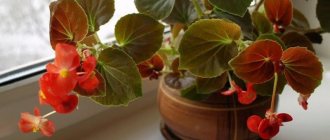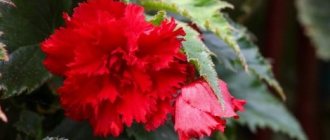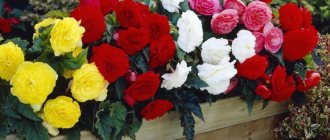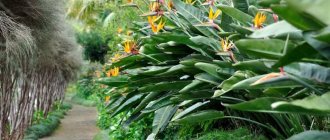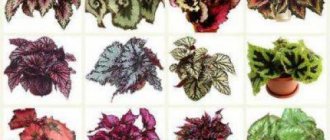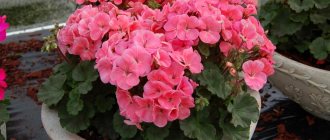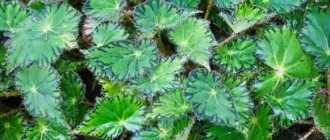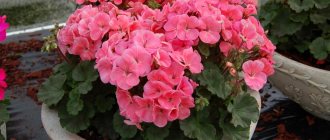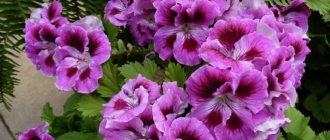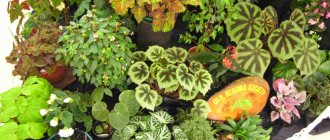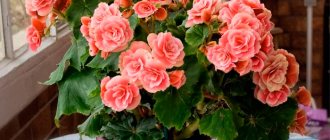Begonia is a unique plant because it is beautiful both with and without inflorescences. All this is thanks to the huge variety of shapes and shades of leaf plates. They are gorgeous in their own right. This is especially true for maple-leaved begonia (for its rich appearance it is also called Cleopatra or Bauer begonia).
In this article we will introduce you to the intricacies of caring for this variety, and also tell you about diseases that can plague the flower.
What does a begonia flower look like: characteristics of the plant
Begonia is a genus of plants containing more than 1,600 different species. Depending on the species, it can grow as a herb, shrub or subshrub.
Description
The root system is divided into three types: branched, fibrous and tuberous.
For your information! Begonias with a tuberous root system, unlike other species, grow well both indoors and in the garden.
The leaves are asymmetrical, can be whole or dissected, with jagged and wavy edges.
Flowering of a representative of the home flora
In plants of the genus Begonia, the upper part of the leaf can be solid green or other colors with various inclusions, strokes, and patterns. The lower part has shades of red, brown and dark purple. The stems and leaves of many species are covered with small hairs.
Inflorescences vary from small to large. They have a wide variety of colors: white, pink, yellow, orange, red, with edging around the edges of the petals. After pollination, fruits are formed in the form of a triangular box with seeds inside.
It usually blooms in summer-autumn, but under indoor conditions flowering continues until December.
Flower care
Caring for begonias at home is easy and simple. Good lighting and the absence of direct sunlight are important for this plant. The most comfortable temperature for a flower is 18 °C.
Landing
Euphorbia flower - types and popular varieties
It is better to plant in spring, at the end of March. Planting in open ground is carried out at the end of March, so as not to frostbite the plant. For this species, it is recommended to choose larger pots. One third of them need to be filled with a drainage layer of expanded clay, coal or shells.
The soil
It is best to use slightly acidic soil (pH = 5.5-6.5), consisting of peat, leaf and turf soil, and coarse river sand.
Note! To increase the acidity of the soil, add calcined soil from coniferous trees.
Watering
Begonia is a tropical plant, so it is necessary to ensure sufficient air humidity in the room (60-70%) to prevent the leaves from drying out. It is recommended to water when the top layer of soil dries to a depth of 1-2 cm. In summer, the plant needs more frequent and abundant watering. Before this, the water is left to settle for 24 hours.
Reproduction
Reproduction is carried out in four ways.
- Seeds. You need to germinate the seeds at the end of January, spreading them on the surface of the ground without sprinkling them. The pot with seeds is placed in a warm, well-lit room, you can put it under a lamp and cover it with film. After four sheets appear, a pick is made. Two months after sowing the seeds, the seedlings are transplanted into individual pots.
- By cuttings. This method is recommended for propagation in early summer. Branches with 3-4 leaves are cut from the bush and placed in a container with water until roots appear. This will happen in about a month. You can also immediately plant the cuttings in the ground and moisten the soil when it dries out by 1 cm.
- By dividing the tuber. This method is used to propagate in the spring. The plant is pulled out of the ground and the tuber is divided into several parts. Each division must have roots. Tubers are planted in separate pots.
- Leaf. Both whole leaves and their parts are suitable for propagation. The main veins are cut into them and placed in calcined soil. The leaves need to be watered through a tray.
Geoglyphs
Another rather ambiguous phenomenon is associated with the drying up of the sea: geoglyph symbols. They were discovered at a depth of 15 meters by specialists from a scientific institute. The figures amaze with their regular shapes. In 1990, the dam failed and the signs were submerged. However, scientists managed to take several photographs of the mysterious geoglyphs.
The Great Aral Sea can no longer be saved. All efforts have been devoted to restoring the Small Lake: a dam has been erected, thanks to which the water level has risen, fish have come, auls and villages have been revived. This is a truly interesting and mysterious place. It requires more detailed study and scientific expeditions to answer many questions.
Begonia everblooming and its types
Types of geranium - what happens, popular varieties
The ever-blooming plant reaches a height of approximately half a meter. The color and size of the leaves differ depending on the variety. The inflorescences of this species are usually small and have two-colored petals.
The Begonia Semperflorens group includes a large number of varieties that bloom regardless of weather conditions throughout the summer.
The most famous varieties:
- Coctail is a low bush with brick-colored leaves and flowers characteristic of the crop;
- Ambassador is a plant with green leaves, a thin red border, flowers can be of various shades. Red begonia of this variety is in great demand;
- Baby Wing - a species with bronze leaves and flowers of various shades;
- Bicola is a low bush measuring only 13 cm. The leaves are green. The flowers are white with a pink edge;
- Alba is a tall spreading bush 40 cm high. The leaf blades are green, the flowers are large, white.
Possible problems during cultivation
A plant that does not receive proper care begins to get sick and may die. The reasons for this may be:
- Low air humidity and poor watering lead to the fact that the flower begins to shed its leaves.
- High humidity when keeping a flower in a cool room provokes the appearance of mold on the flowers. In this case, they need to be removed and the bush treated with fungicides.
- With insufficient lighting, the leaves turn pale and lose their decorative properties.
- At home, begonia can be affected by spider mites or aphids. If there are still few pests, then the above-ground part of the plant must be sprayed several times with a soap solution. Otherwise, the use of Intavir or Karbofos is recommended.
- The ideal conditions for the development of powdery mildew on a plant are sudden temperature changes and too dry indoor air. The first sign of the disease is the appearance of a white coating on the leaves and stems. The affected bush is treated with sulfur or fungicides.
In order for your green pet to please you with its healthy appearance and decorativeness, it needs to be provided with the right conditions and optimal care.
Royal begonia: types, varieties
Dracaena - types and popular varieties
Begonia Rex is a hybrid species of ornamental plant. The differences between this variety are its rather large leaves and small flowers (up to 1 cm in diameter).
The most popular varieties of Begonia rex:
Royal begonia
- Escargot is a bush-like plant up to 30 cm in height and 45 cm in diameter. The leaves are twisted in a spiral, they are light green with a dark edge, covered with villi;
- Mini Merry Christmas is the most variegated variety, measuring approximately 30 cm. Leaves have a velvety surface and large veins. Painted in the middle and along the edges in a dark brown, copper color, turning into burgundy red with light green splashes;
- Dollar Down is a bush measuring 25-30 cm. The leaves of this variety are dark red, cherry, dark along the edges, and have a fan shape;
- Dark Mambo is a plant with dark, almost black spiral-shaped leaves;
- Griffin is a flower 40 cm in size. The leaf blades are mostly white with green veins.
Characteristic features of the flower culture “begonia”
- Begonia inflorescences are distinguished by unequal shape, size and color of flowers and leaves. Begonia blooms in warm and bright seasons.
- The color of the leaf surface of begonia is bright green, light green, emerald, red-brown, red-green, bronze, brown-green. The leaf pattern is often decorated with various patterns: stripes, spots, dots and specks.
- Begonia leaf shapes vary. According to the geometric shapes, the begonia leaf is often round, oval, elongated, lanceolate, wedge-shaped, heart-shaped, pointed. A unique feature of begonia leaves is the pubescent hairs. The begonia family includes shrub and semi-shrub species, but these are mainly herbaceous varieties with succulent, fleshy leaves that are rarely arranged symmetrically.
Elatior
Elatior is a small bush, reaching 25-40 cm in height. The leaves are dense, approximately 8 cm long, and shaped like an asymmetrical heart with jagged edges. Elatior flowers come in two types: simple and double. They form inflorescences in the form of a cascade.
Elatior
The most common varieties of Elatior:
- Balladin. It is distinguished by the splendor of flowering. During this, up to 70 pieces appear on one bush. colors;
- Begonia Borias. The main feature is long flowering.
Ampelnaya
The main difference between the ampel type and other varieties is the tuberous root system. The plant reaches a height of about half a meter. The leaf blades are large, 10-15 cm long. It blooms with bright yellow, orange or red flowers, which can be simple or fringed in type.
Ampelnaya
Note! The most famous varieties are Reyvans, Marmorat and Chardon.
Transfer
Expert experts strongly recommend not to replant begonia unless absolutely necessary. It is better to approach planting after purchase as responsibly as possible, carefully excluding violations. The fact is that the root system of the plant is highly sensitive. The most insignificant damage at first glance can turn out to be disastrous. Having bought a begonia, you need to store it in a transport pot until flowering is completed.
Sometimes there is a need to replant the crop at an earlier date. Then you will have to act even more carefully. The standard approach involves watering the soil 4-6 hours before starting work. The bottom of the selected container is covered with a drainage layer. Its best options are expanded clay and sphagnum.
Next, carefully selected and tested soil is filled in.
When removing a plant from an old pot, you need to preserve the lump of earth as completely as possible. In this form it is transferred to a new container.
Immediately add soil mixture. It needs to be compacted a little and watered. The intensity of watering should not be excessive.
Coralline
Coral begonia is a tall bush, reaching up to 2 m in height in a greenhouse garden, and will be slightly smaller in indoor conditions. Coralline leaves are 20 cm long and up to 7 cm wide. They are unevenly colored and have white inclusions. During flowering, bright flowers appear in white, orange, pink or red shades.
Coral
Other popular varieties
The following varieties are in great demand among gardeners.
- Begonia Cleopatra. A plant of this species usually reaches no more than 30 cm in height. Its leaves resemble maple leaves. They come in green and burgundy. Cleopatra blooms in January. Inflorescences are white and pink.
- Begonia Mason. It is a leafy variety with a height of approximately 30 cm. The leaves reach 20 cm in length. The flowers are small and beige.
- Fuchsia. Reaches a height of 1 m. The leaves are glossy green. The flowers are painted in bright shades of red.
- Bud de Rose is a large-flowered variety. The delicate pink petals are collected in huge double inflorescences (18 cm in diameter), reminiscent of a rose.
- Begonia Gloire de Lorraine is a winter-blooming species. The plant is small with glossy leaves. The petals are pink.
- Begonia hogweed
- Large-leaved variety. The leaves reach 25 cm. The shape resembles the leaf plate of hogweed, which is why the plant got its name.
- Begonia castor-leaved is a decorative deciduous species that reaches more than 1 m in height. During flowering, delicate pink inflorescences appear.
- Grandiflora is a species with a tuberous root system. The height of the plant depends on the variety. The size varies between 20 and 80 cm. Popular varieties of grandiflora: Orange (low bush 25-30 cm, dark green glossy leaf plates are collected in a rosette, flowers reach a diameter of 10-15 cm); Rose is a small plant with large, rose-like, densely double pink flowers; Yellow - bush 20-25 cm; the Yellow variety is characterized by densely double lemon-colored flowers with a diameter of 10-12 cm.
- Maculata, or spotted begonia. It grows as a bush with large spotted leaves 10-15 cm long. During flowering, the inflorescences form hanging clusters of white and pink flowers.
- Black Prince. The leaves of this variety are painted in a very dark color, close to black. The surface of the sheet resembles velvet.
- Fimbriatus. A plant of the fringed group with a wide variety of colors: pink, red, white, orange. Yellow begonia of this variety looks especially impressive.
- Illumination This variety is characterized by long shoots up to 0.8 m. Illumination flowers are large, up to 12 cm in diameter.
- Carnival. Large-flowered variety, 30-35 cm high. Flowers are camellia-shaped, densely double.
- Drega is a begonia with a caudex trunk.
Note! There are also many more varieties and species, for example, Nona, Nha Trang, Pendula, begonia Belleconia, etc. The diversity of the genus Begonia allows each plant grower to choose a specimen that he likes. This elegant plant will decorate any room with its bright colors.
Coffee capsule Nescafe Dolce Gusto Chocochino, 3 packs of 16 capsules
1305 ₽ More details
Hot chocolate capsules Nescafe Dolce Gusto Chococino, 8 servings
334 ₽ More details
Bed sheets
Useful video
Begonia care video:
If you find an error, please select a piece of text and press Ctrl+Enter.
Sitting under house arrest after the operation, today I decided to put up for sale on microstock several of my photographs, which I took during one of my walks around the city and was seriously puzzled during the so-called work with one of them.
Walking near a small flower bed, I saw some strange plant, an upright shrub somewhat reminiscent of a blackberry . Then I didn’t attach much importance to these photographs, but now, before putting them up for sale, I had to find out what kind of plant it was and what it was called.
In fact, here is one of several photographs showing berries from this bush, which in appearance resemble blackberries.

